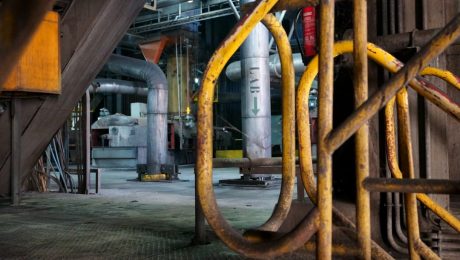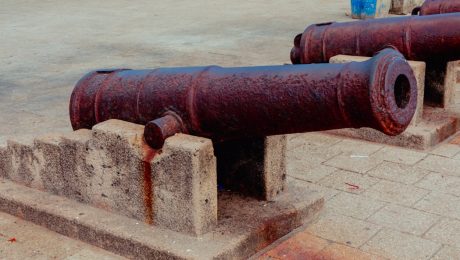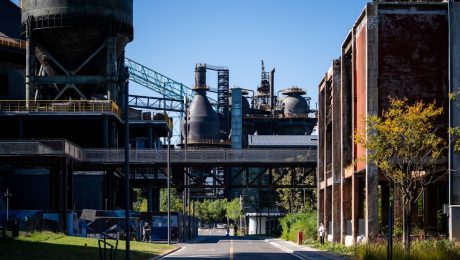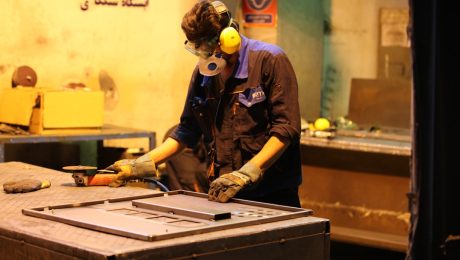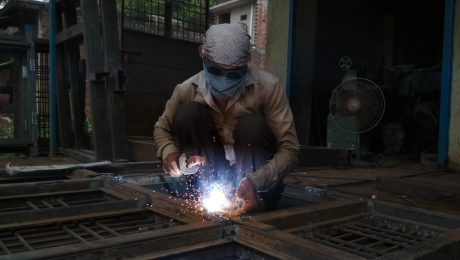body { font-family: sans-serif; line-height: 1.6; }
h1, h2, h3 { color: #333; }
img { max-width: 100%; height: auto; }
The oil and gas industry relies heavily on efficient and reliable well construction. Two critical components integral to this process are casing and tubing. These steel pipes, while seemingly simple, play multifaceted roles in ensuring safe, productive, and environmentally responsible extraction of hydrocarbons. This comprehensive guide delves into the intricacies of casing and tubing, exploring their functions, types, materials, and installation processes.
Understanding the Purpose of Casing in Oil & Gas Wells
Casing is the foundational steel pipe system that lines a wellbore from the surface to the target reservoir. Its primary function is to provide structural integrity and stability to the well. As drilling progresses through various geological formations, some of which can be unstable or prone to collapse, casing prevents the wellbore from caving in. This is crucial for safety, preventing loss of drilling fluids and equipment, and ensuring the well’s long-term productivity.
Beyond structural support, casing serves several other vital purposes:
- Preventing fluid migration: Casing isolates different geological formations, preventing the mixing of fluids and maintaining pressure control. This is essential to prevent blowouts and other hazardous events.
- Protecting freshwater aquifers: Casing prevents contamination of freshwater aquifers by isolating them from the wellbore and the produced hydrocarbons.
- Providing a pathway for production: Once the reservoir is reached, casing provides a conduit for the flow of oil and gas to the surface.
- Supporting cementing operations: The annular space between the casing and the wellbore is filled with cement, which further enhances wellbore stability and prevents fluid migration.
Types and Grades of Casing Pipes
Casing pipes come in various grades and sizes, each designed to withstand specific pressures and temperatures. The selection of casing depends on the well’s depth, the geological formations encountered, and the expected reservoir pressure. Common casing grades include:
- J-55, K-55, N-80, L-80, C-90, P-110, and higher: These designations indicate the yield strength of the steel pipe, with higher values signifying greater strength and pressure resistance.
Casing is also categorized by its diameter, weight per foot, and length. Larger diameter casing is typically used in shallower sections of the well, while smaller diameter casing is used at greater depths.
The Role of Tubing in Oil & Gas Production
While casing provides the structural support and isolation, tubing is the internal pipe system through which hydrocarbons are produced from the reservoir to the surface. Tubing is typically smaller in diameter than casing and is run inside the casing string. Its main function is to transport the extracted oil and gas efficiently and safely.
Tubing also plays a critical role in:
- Artificial lift: Tubing is often used in conjunction with artificial lift systems, such as pumps or gas lift, to enhance production from low-pressure reservoirs.
- Injection of fluids: Tubing can be used to inject fluids into the reservoir, such as water for enhanced oil recovery or chemicals for stimulation.
- Monitoring well conditions: Sensors and other downhole tools can be run through the tubing to monitor pressure, temperature, and other parameters in the well.
Materials and Manufacturing of Casing and Tubing
Both casing and tubing are primarily manufactured from high-strength steel. The steel is carefully selected to meet the required yield strength, corrosion resistance, and other specifications. The manufacturing process involves seamless or welded pipe production, followed by rigorous quality control testing to ensure that the pipes meet the required standards. Advanced manufacturing techniques are employed to produce pipes with enhanced mechanical properties and resistance to corrosion and other forms of degradation.
In specific applications, specialized materials like corrosion-resistant alloys or composite materials might be used to address unique challenges such as high temperatures, corrosive environments, or high levels of hydrogen sulfide.
Installation and Completion of Casing and Tubing
The installation of casing and tubing is a complex and critical operation requiring specialized equipment and expertise. Casing is run into the wellbore using a drilling rig, with cementing operations performed between the casing and the wellbore to provide additional support and isolation. Tubing is subsequently run inside the casing, often using specialized tools and techniques to ensure proper placement and connection. The entire process requires meticulous planning and execution to ensure the safety and efficiency of the operation.
The completion of a well involves the installation of various downhole components, such as packers, perforations, and production equipment, to optimize hydrocarbon production. The casing and tubing strings form the backbone of this completion process, ensuring the integrity and longevity of the well.
In conclusion, understanding the crucial roles of casing and tubing in oil and gas operations is essential for anyone involved in the industry. These seemingly simple steel pipes are fundamental to safe, efficient, and environmentally responsible hydrocarbon production.
Tags: casing, tubing, oil and gas, well completion, drilling
Industrial pipes are the unsung heroes of manufacturing, silently transporting vital fluids and gases that fuel production processes. Choosing the right pipes is crucial for efficiency, safety, and longevity. This comprehensive guide delves into the key considerations for selecting the perfect industrial pipes for your manufacturing facility.
1. Material Selection: The Foundation of Durability
The choice of material for your industrial pipes is paramount. Different materials offer varying levels of strength, corrosion resistance, temperature tolerance, and cost-effectiveness. Common materials include:
- Carbon Steel: A versatile and cost-effective option suitable for a wide range of applications. However, it’s susceptible to corrosion, requiring protective coatings or galvanization in certain environments.
- Stainless Steel: Known for its exceptional corrosion resistance and high strength, stainless steel is ideal for handling corrosive chemicals and high-temperature applications. Different grades (like 304 and 316) offer varying levels of resistance.
- Cast Iron: Offers good strength and pressure resistance but is heavier and more brittle than steel. It’s often used in less demanding applications or for specific purposes like drainage.
- Copper: Excellent corrosion resistance and thermal conductivity make copper suitable for water and refrigerant lines. However, it’s softer and more expensive than steel.
- Plastic Pipes (PVC, CPVC, HDPE): Lightweight, corrosion-resistant, and cost-effective, plastic pipes are suitable for applications where chemical resistance is crucial. However, they may have lower temperature and pressure limitations compared to metal pipes.
The selection process should carefully consider the specific fluids being transported, the operating temperature and pressure, and the overall environmental conditions.
2. Pressure Ratings and Flow Capacity: Optimizing Performance
Industrial pipes are designed to withstand specific pressure levels. Understanding the pressure rating (often expressed in PSI or bar) is crucial to prevent leaks, bursts, and catastrophic failures. The required pressure rating depends on the application and the working pressure of the system. Incorrectly sized pipes can lead to reduced flow capacity, impacting production efficiency. Factors influencing flow capacity include pipe diameter, material, and the viscosity of the transported fluid. Careful hydraulic calculations are essential to ensure adequate flow rates and minimize pressure drops.
3. Safety Regulations and Compliance: Prioritizing Safety
Safety is paramount in any manufacturing environment. Industrial pipe systems must adhere to strict safety regulations and standards, varying by region and industry. These regulations often cover aspects like material selection, pressure testing, leak detection, and emergency shutdown procedures. Compliance with relevant codes and standards (such as ASME B31.1 or ASME B31.3) is not only essential for avoiding penalties but also for ensuring the safety of workers and preventing environmental damage. Regular inspections and maintenance are crucial to maintaining compliance and identifying potential issues before they escalate.
4. Installation and Maintenance: Ensuring Long-Term Reliability
Proper installation is crucial for the long-term reliability and safety of industrial pipe systems. This involves careful planning, skilled labor, and adherence to manufacturer’s instructions. Factors such as proper pipe support, correct jointing techniques, and accurate alignment are all vital for preventing leaks and ensuring the system’s integrity. Regular maintenance, including inspections for corrosion, leaks, and wear, is essential for preventing unexpected failures and extending the lifespan of the pipe system. A well-maintained system minimizes downtime, reduces repair costs, and ensures continuous production.
5. Cost Considerations and Lifecycle Analysis: Balancing Value and Performance
While upfront costs are a factor in pipe selection, a lifecycle analysis is crucial for making informed decisions. This involves considering factors like initial purchase cost, installation cost, maintenance cost, and the expected lifespan of the pipe system. While a cheaper material might seem attractive initially, its shorter lifespan and higher maintenance costs could outweigh the initial savings. A more expensive, durable material might offer significant long-term cost savings through reduced maintenance and extended operational life. Careful consideration of these factors is essential for optimizing the overall value and performance of the industrial pipe system.
Choosing the right industrial pipes is a critical decision with far-reaching consequences. By carefully considering material selection, pressure ratings, safety regulations, installation, and lifecycle costs, manufacturers can ensure the efficient, safe, and reliable operation of their facilities. Remember to consult with experienced engineers and suppliers to find the optimal solution for your specific needs.
SEO Tags:
- Industrial Pipes
- Manufacturing Pipes
- Industrial Pipe Selection
- Pipe Materials for Manufacturing
- Industrial Pipe Systems
body { font-family: sans-serif; line-height: 1.6; }
h1, h2, h3 { color: #333; }
img { max-width: 100%; height: auto; }
Industrial pipes are the unsung heroes of manufacturing, silently transporting crucial fluids, gases, and slurries throughout your facility. The choice of pipe material, size, and construction significantly impacts efficiency, safety, and the overall lifespan of your operations. This comprehensive guide delves into the critical considerations for selecting the right industrial pipes for your manufacturing needs.
Understanding Industrial Pipe Materials: A Deep Dive
The selection of pipe material is paramount, dictated by the transported medium’s properties (temperature, pressure, corrosiveness) and environmental conditions. Common materials include:
- Carbon Steel: A versatile and cost-effective option for applications with moderate temperatures and pressures. It’s strong and readily available but susceptible to corrosion, necessitating protective coatings or galvanization in certain environments.
- Stainless Steel: Superior corrosion resistance makes stainless steel ideal for handling aggressive chemicals, high-purity fluids, and applications requiring hygiene (e.g., food and pharmaceutical industries). Different grades (304, 316, etc.) offer varying levels of corrosion resistance and strength.
- Ductile Iron: Offers high strength and ductility, making it suitable for high-pressure applications and underground installations. Its resistance to corrosion is generally good, but coatings may be needed in aggressive environments.
- PVC (Polyvinyl Chloride): A lightweight and corrosion-resistant option for low-pressure applications handling non-aggressive chemicals. PVC pipes are cost-effective but have limitations in terms of temperature and pressure resistance.
- CPVC (Chlorinated Polyvinyl Chloride): A superior alternative to PVC, offering higher temperature and pressure resistance. It’s suitable for hot water and certain chemical applications.
- High-Density Polyethylene (HDPE): Known for its excellent chemical resistance, flexibility, and impact strength. HDPE is often used for underground piping systems and applications requiring long lengths without joints.
Industrial Pipe Applications Across Manufacturing Sectors
The diversity of manufacturing processes necessitates a wide range of pipe applications. Here are some examples:
- Chemical Processing: Stainless steel and other corrosion-resistant materials are crucial for handling various chemicals and preventing contamination.
- Food and Beverage: Sanitary stainless steel pipes are essential to maintain hygiene and prevent product contamination. Cleanability and ease of sterilization are key considerations.
- Pharmaceutical Manufacturing: Strict regulations require high-purity materials and seamless pipe systems to ensure product integrity and prevent cross-contamination.
- Oil and Gas: High-strength steel pipes are necessary to withstand high pressures and temperatures. Specialized coatings and linings are often used to prevent corrosion and erosion.
- Power Generation: High-temperature and high-pressure applications often utilize specialized alloys and advanced pipe designs to ensure safety and efficiency.
Ensuring Safety and Compliance with Industrial Pipe Systems
Safety is paramount in industrial settings. Proper pipe selection, installation, and maintenance are crucial to prevent leaks, ruptures, and other hazards. This includes:
- Regular Inspections: Visual inspections, pressure testing, and non-destructive testing (NDT) methods help identify potential issues before they escalate.
- Proper Support and Anchoring: Pipes need adequate support to prevent sagging, vibrations, and stress concentrations that could lead to failure.
- Correct Installation Techniques: Following manufacturer’s guidelines and industry best practices ensures leak-free joints and a secure system.
- Emergency Shutdown Systems: Implementing quick-release valves and other safety mechanisms allows for rapid response in case of leaks or emergencies.
- Compliance with Regulations: Adhering to relevant codes and standards (e.g., ASME, ASTM) ensures safety and legal compliance.
Maintenance and Repair of Industrial Pipes: Proactive Strategies
Proactive maintenance is crucial for extending the lifespan of industrial pipe systems and preventing costly downtime. This involves:
- Regular Cleaning and Flushing: Removing deposits and buildup prevents corrosion and maintains flow efficiency.
- Corrosion Protection: Applying coatings, linings, or cathodic protection systems extends the life of pipes in corrosive environments.
- Leak Detection and Repair: Promptly addressing leaks prevents further damage and ensures operational safety.
- Scheduled Inspections and Testing: Regular assessments identify potential problems before they become major issues.
- Pipe Replacement: Replacing aging or damaged pipes prevents failures and ensures continued reliable operation.
Selecting the Right Industrial Pipes: A Step-by-Step Guide
Choosing the right industrial pipes requires a systematic approach. Consider these factors:
- Fluid Properties: Identify the fluid being transported (e.g., temperature, pressure, corrosiveness, viscosity).
- Environmental Conditions: Assess the surrounding environment (e.g., temperature fluctuations, soil conditions, potential for corrosion).
- Flow Rate and Pressure: Determine the required flow rate and pressure to select the appropriate pipe diameter and wall thickness.
- Budgetary Constraints: Balance material cost, installation cost, and maintenance cost to find the most economical solution.
- Regulatory Compliance: Ensure the chosen pipes meet all relevant safety and industry standards.
- Long-term Maintenance Considerations: Factor in the ease of maintenance and the potential for future repairs.
By carefully considering these factors, manufacturers can select the optimal industrial pipes to ensure efficient, safe, and reliable operations.
SEO Tags:
Industrial Pipes, Manufacturing Pipes, Pipe Selection, Industrial Pipe Materials, Pipe Maintenance
The steel industry, a cornerstone of global infrastructure, faces a critical challenge: minimizing its environmental footprint. Traditional steel production is energy-intensive and contributes significantly to greenhouse gas emissions. However, a growing movement towards sustainable steel supply chains is transforming the industry, offering a path towards a greener future. This post delves into the key aspects of creating and implementing these sustainable practices.
1. Sustainable Raw Material Sourcing: The Foundation of Green Steel
The journey towards sustainable steel begins with the raw materials. Traditional steelmaking relies heavily on iron ore, coking coal, and limestone, all of which have significant environmental impacts. Mining activities can lead to deforestation, habitat loss, and water pollution. Coking coal, in particular, is a major source of greenhouse gas emissions. Sustainable steel supply chains prioritize responsible sourcing, focusing on:
- Reduced reliance on coking coal: Innovations like hydrogen-based steelmaking and the use of biomass offer promising alternatives to significantly reduce carbon emissions during the steelmaking process.
- Sustainable mining practices: Implementing methods that minimize land disturbance, water consumption, and waste generation is crucial. This includes employing techniques like precision mining and responsible tailings management.
- Recycled steel: Using scrap steel as a raw material is one of the most effective ways to reduce the environmental impact of steel production. Scrap steel requires significantly less energy to process compared to virgin materials.
- Traceability and transparency: Knowing the origin and environmental impact of raw materials is essential. Blockchain technology and other tracking systems can enhance transparency throughout the supply chain.
2. Energy Efficiency and Renewable Energy Integration
Steel production is an energy-intensive process. Minimizing energy consumption and transitioning to renewable energy sources are critical for reducing the carbon footprint of steelmaking. Strategies include:
- Optimizing production processes: Implementing advanced technologies and process optimization techniques can significantly reduce energy consumption per ton of steel produced.
- Investing in renewable energy: Powering steel mills with renewable energy sources like solar, wind, and hydropower reduces reliance on fossil fuels and lowers greenhouse gas emissions.
- Improving energy efficiency in transportation: Optimizing logistics and utilizing more fuel-efficient transportation methods can minimize energy consumption during the transportation of raw materials and finished products.
- Carbon capture and storage (CCS): CCS technologies can capture CO2 emissions from steel mills and store them underground, preventing their release into the atmosphere. While still under development, CCS holds significant potential for decarbonizing steel production.
3. Waste Reduction and Recycling: Closing the Loop
Minimizing waste and maximizing recycling are crucial components of a sustainable steel supply chain. This involves:
- Implementing waste management strategies: Steel mills should adopt comprehensive waste management plans to reduce, reuse, and recycle waste materials, minimizing landfill disposal.
- Improving recycling infrastructure: Investing in and expanding recycling facilities is essential to ensure efficient collection and processing of scrap steel.
- Designing for recyclability: Products should be designed with recyclability in mind, making it easier to recover and reuse the steel at the end of its life cycle.
- Promoting the use of recycled steel: Encouraging the use of recycled steel in construction, manufacturing, and other industries creates a circular economy for steel.
4. Collaboration and Transparency Across the Supply Chain
Building a truly sustainable steel supply chain requires collaboration and transparency among all stakeholders, including steel producers, suppliers, manufacturers, and consumers. This includes:
- Sharing best practices: Open communication and knowledge sharing among industry players can accelerate the adoption of sustainable practices.
- Developing industry standards: Establishing clear standards for sustainable steel production and supply chain management ensures accountability and transparency.
- Engaging with stakeholders: Involving all stakeholders, including NGOs and consumers, in the development and implementation of sustainable practices fosters a shared commitment to environmental responsibility.
- Using technology for traceability: Blockchain and other technologies can enhance transparency and traceability throughout the supply chain, allowing consumers to verify the sustainability of the steel products they purchase.
5. Life Cycle Assessment (LCA) and Continuous Improvement
Conducting a comprehensive Life Cycle Assessment (LCA) is crucial for evaluating the environmental impact of steel products throughout their entire life cycle, from raw material extraction to end-of-life management. This data-driven approach enables continuous improvement by identifying areas for optimization and innovation. Regular LCA updates allow companies to track progress and identify new opportunities for sustainability improvements.
Building sustainable steel supply chains is a complex but necessary undertaking. By embracing innovative technologies, collaborating across the industry, and committing to continuous improvement, the steel industry can significantly reduce its environmental impact and contribute to a more sustainable future.
SEO Tags: Sustainable Steel, Green Steel, Steel Supply Chain, Sustainable Manufacturing, Circular Economy
Prefabricated steel structures are revolutionizing the construction industry, offering a faster, more efficient, and cost-effective alternative to traditional building methods. From towering warehouses to sleek modern homes, these structures are proving their versatility and strength across a range of applications. This comprehensive guide will delve into the world of prefabricated steel, exploring its advantages, design process, applications, cost considerations, and future trends.
The Advantages of Prefabricated Steel Structures
Prefabricated steel structures boast numerous advantages over traditional construction methods. One of the most significant is speed of construction. Because the components are manufactured off-site, the on-site construction time is dramatically reduced. This translates to faster project completion and quicker return on investment. Furthermore, steel’s inherent strength and durability ensures long-lasting structures that can withstand harsh weather conditions and seismic activity. Steel is also highly resistant to pests and fire, offering superior protection compared to wood or other materials. The precision engineering involved in prefabrication minimizes errors and waste, leading to a more efficient and sustainable building process. Finally, the ease of modification and expansion makes these structures adaptable to future needs.
The Design and Fabrication Process of Prefabricated Steel Structures
The design process begins with detailed architectural and engineering plans. These plans are then used to create precise 3D models, allowing for accurate component fabrication. The steel components, including beams, columns, and panels, are manufactured in a controlled factory environment, ensuring high quality and consistency. This process involves advanced technologies like Computer-Aided Design (CAD) and Computer-Aided Manufacturing (CAM) for precise cutting, welding, and assembly. Once fabricated, the components are transported to the construction site for assembly. The on-site assembly is typically faster and simpler due to the pre-engineered nature of the components, requiring less labor and expertise compared to traditional construction.
Diverse Applications of Prefabricated Steel Structures
Prefabricated steel structures find applications across a wide range of sectors. In the industrial sector, they are commonly used for warehouses, factories, and workshops. Their strength and large spans make them ideal for storing heavy materials and housing large machinery. In the commercial sector, they are utilized for retail spaces, office buildings, and shopping malls, offering flexibility and speed of construction. The residential sector is also seeing a growing adoption of prefabricated steel structures for homes and apartments, providing modern designs and energy-efficient options. Furthermore, they are used extensively in the agricultural sector for barns, silos, and greenhouses, offering durability and resistance to the elements. Finally, infrastructure projects such as bridges and overpasses also benefit from the speed and efficiency of prefabricated steel components.
Cost-Effectiveness of Prefabricated Steel Structures: A Detailed Analysis
While the initial material costs might seem higher compared to some traditional materials, the overall cost-effectiveness of prefabricated steel structures becomes apparent when considering the long-term benefits. Reduced labor costs due to faster construction, minimized waste, and lower transportation costs due to efficient component design contribute to significant savings. The durability and longevity of steel structures also reduce the need for frequent maintenance and repairs, further enhancing their cost-effectiveness. Moreover, the precision of prefabrication leads to less rework and fewer errors, minimizing project delays and cost overruns. However, it’s crucial to factor in transportation costs, especially for remote locations, and the potential need for specialized equipment for assembly.
Future Trends in Prefabricated Steel Structures
The future of prefabricated steel structures is bright, driven by technological advancements and growing demand for sustainable and efficient construction methods. Modular construction, where entire building modules are prefabricated and assembled on-site, is gaining traction, allowing for even faster construction and greater design flexibility. The integration of smart technologies, such as sensors and IoT devices, is transforming these structures into smart buildings, enhancing energy efficiency and occupant comfort. Sustainable practices are also becoming increasingly important, with the use of recycled steel and innovative design solutions to minimize environmental impact. Furthermore, advancements in 3D printing technology hold the potential to revolutionize steel fabrication, allowing for the creation of complex and customized structures with unprecedented speed and precision.
In conclusion, prefabricated steel structures represent a significant advancement in the construction industry, offering a compelling combination of speed, efficiency, durability, and cost-effectiveness. As technology continues to evolve, these structures are poised to play an even greater role in shaping the built environment of the future.
In the world of construction, manufacturing, and engineering, the safety and reliability of materials are paramount. Steel, a cornerstone of countless structures and products, demands rigorous quality control. This is where CE certification comes in, acting as a crucial stamp of approval, assuring consumers and businesses alike of a product’s compliance with stringent European Union safety, health, and environmental protection standards. This guide dives deep into the world of CE-certified steel products, providing you with a thorough understanding of their significance and what they mean for you.
What Does CE Certification Mean for Steel Products?
The CE marking (Conformité Européenne) is a mandatory conformity marking for products sold within the European Economic Area (EEA). It signifies that the product meets the essential requirements of the relevant EU directives and regulations. For steel products, this means that they have undergone rigorous testing and evaluation to ensure they meet specific safety, health, and environmental standards. These standards cover aspects like mechanical properties (tensile strength, yield strength, elongation), chemical composition, dimensional accuracy, and surface finish. The specific directives applicable to steel products vary depending on their intended use and type (e.g., structural steel, reinforcing steel, steel pipes).
The Rigorous Process of CE Certification for Steel
Achieving CE certification for steel products is not a simple process. It involves several key steps:
- Product Design and Specification: The manufacturer must meticulously design the steel product to meet all relevant EU directives and standards. This includes detailed specifications regarding material composition, manufacturing processes, and performance characteristics.
- Internal Production Control: Robust internal quality control systems are essential. These systems ensure consistent product quality throughout the manufacturing process, including regular testing and inspection to detect any deviations from specifications.
- Conformity Assessment: This involves demonstrating compliance with the relevant directives. This can be achieved through various methods, including internal production control, type-examination, and third-party conformity assessment. Often, a Notified Body, an independent organization designated by a Member State, will be involved in verifying the manufacturer’s claims.
- Documentation and Declaration of Conformity: Manufacturers must maintain comprehensive documentation demonstrating compliance with all relevant requirements. This includes test results, manufacturing processes, and quality control procedures. A formal Declaration of Conformity must be issued, stating that the product meets the essential requirements.
- CE Marking Application: Finally, the CE marking is affixed to the product, usually accompanied by the manufacturer’s identification and relevant product information.
Benefits of Choosing CE-Certified Steel Products
Opting for CE-certified steel products offers numerous advantages:
- Enhanced Safety: The rigorous testing and certification process ensures that the steel products meet high safety standards, minimizing risks of structural failure, accidents, and injuries.
- Improved Quality: CE certification assures consistent product quality, reducing the likelihood of defects and enhancing the overall performance and longevity of the product.
- Legal Compliance: Using CE-certified steel products ensures full compliance with EU regulations, avoiding potential legal penalties and liabilities.
- Increased Market Access: The CE marking facilitates easier access to the EEA market, opening up opportunities for both manufacturers and consumers.
- Enhanced Reputation: Choosing CE-certified products enhances the reputation of businesses, demonstrating a commitment to quality and safety.
Common Applications of CE-Certified Steel Products
CE-certified steel finds its way into a vast array of applications, including:
- Construction: Structural steel, reinforcing bars, and steel sections used in buildings, bridges, and other infrastructure projects.
- Manufacturing: Steel components used in machinery, automotive parts, and other industrial applications.
- Energy Sector: Steel pipes and components used in pipelines, power plants, and renewable energy infrastructure.
- Transportation: Steel used in the construction of vehicles, railway tracks, and ships.
- Consumer Goods: Steel components in appliances, furniture, and other everyday products.
Identifying Genuine CE-Certified Steel Products
It’s crucial to be able to identify genuine CE-certified steel products. Look for the following:
- The CE Marking: The CE marking itself should be clearly visible and correctly affixed to the product or its packaging.
- Manufacturer’s Identification: The manufacturer’s identification number should be included alongside the CE marking.
- Declaration of Conformity: Manufacturers are obligated to provide a Declaration of Conformity upon request. This document provides detailed information about the product’s compliance with relevant EU directives.
- Notified Body Involvement (if applicable): If a Notified Body was involved in the certification process, their identification number may be included on the product or documentation.
- Reputable Suppliers: Sourcing products from reputable and established suppliers significantly reduces the risk of encountering counterfeit or non-compliant products.
By carefully examining these elements, you can significantly increase your confidence in the authenticity and compliance of the CE-certified steel products you purchase.
In conclusion, CE certification is more than just a mark; it’s a guarantee of quality, safety, and compliance. Understanding the significance of CE-certified steel products is essential for ensuring the safety and reliability of any project or application involving steel. By making informed choices, you can contribute to safer and more sustainable practices across various industries.
SEO Tags:
CE certified steel, steel certification, European steel standards, construction steel, safety standards steel
In the competitive landscape of the B2B steel industry, understanding your customer is paramount to success. Generic marketing strategies rarely yield optimal results. To maximize your ROI and drive sales, you need a laser-focused approach. This starts with effective customer segmentation. This guide will delve into the nuances of segmenting your B2B steel customers, helping you tailor your strategies for maximum impact.
1. Understanding the Importance of B2B Steel Customer Segmentation
Segmentation isn’t just about dividing your customer base into arbitrary groups; it’s about identifying distinct customer profiles based on shared characteristics and needs. By understanding these shared traits, you can tailor your marketing and sales efforts to resonate more effectively with each segment. In the steel industry, where products range from raw materials to specialized alloys, a blanket approach is inefficient and costly. For example, a construction company’s needs differ drastically from those of an automotive manufacturer. Segmentation allows you to:
- Improve Marketing ROI: By targeting specific segments with relevant messaging, you avoid wasted resources on ineffective campaigns.
- Increase Sales Conversion Rates: Personalized messaging and targeted offers resonate more strongly with specific customer needs, leading to higher conversion rates.
- Enhance Customer Loyalty: Demonstrating an understanding of their unique needs fosters stronger relationships and builds loyalty.
- Develop More Effective Pricing Strategies: Understanding the value proposition for different segments allows for more nuanced and profitable pricing.
- Identify New Market Opportunities: Segmentation can reveal untapped market segments with high potential.
2. Key Variables for Segmenting B2B Steel Customers
Several key variables can be used to segment your B2B steel customers. These variables should be chosen based on their relevance to your business goals and the nature of your products and services. Some key variables include:
- Industry: Construction, automotive, manufacturing, energy – each industry has unique steel requirements and buying processes.
- Company Size: Small, medium, and large enterprises have different purchasing power, needs, and decision-making processes.
- Geographic Location: Proximity to your facilities impacts logistics and delivery costs. Regional variations in regulations and industry standards also play a role.
- Steel Grade and Quantity Purchased: This reveals the type of projects your customers undertake and their production scale.
- Purchasing Behavior: Frequency of purchases, order size, payment terms, and responsiveness to marketing efforts provide insights into customer preferences.
- Relationship Stage: New customers require a different approach than long-term, established clients.
3. Implementing Effective Segmentation Strategies
Once you’ve identified the key variables, you need to implement a strategy for segmenting your customers. Several approaches can be used, often in combination:
- Demographic Segmentation: This focuses on observable characteristics like company size, location, and industry.
- Behavioral Segmentation: This considers customer actions, such as purchase history, frequency, and responsiveness to marketing.
- Psychographic Segmentation: This delves into the values, attitudes, and beliefs of your customers, which can be more challenging to ascertain but incredibly valuable.
- Needs-Based Segmentation: This groups customers based on their specific needs and how your steel products address those needs. This is particularly relevant in the steel industry due to the wide range of applications.
Consider using data analytics tools to analyze your customer data and identify distinct segments. Clustering algorithms can help group similar customers together automatically.
4. Tailoring Your Marketing and Sales Strategies
Once your customer segments are defined, you can tailor your marketing and sales strategies to each group. This involves developing personalized messaging, targeted offers, and customized sales approaches. For example:
- Targeted Advertising: Use online advertising platforms to reach specific customer segments with relevant ads.
- Personalized Email Marketing: Craft email campaigns that speak directly to the needs and interests of each segment.
- Content Marketing: Develop valuable content (case studies, white papers, blog posts) that addresses the specific challenges and opportunities faced by each segment.
- Sales Training: Equip your sales team with the knowledge and skills to effectively engage with different customer segments.
- Customized Pricing and Packaging: Offer different pricing and packaging options to cater to the specific needs and budgets of each segment.
5. Measuring the Success of Your Segmentation Strategy
Regularly monitoring and evaluating the success of your segmentation strategy is crucial. Key metrics to track include:
- Conversion Rates: Are your targeted marketing campaigns converting leads into customers at a higher rate?
- Customer Lifetime Value (CLTV): Are your segmented marketing efforts leading to increased customer lifetime value?
- Sales Growth: Is your segmentation strategy contributing to overall sales growth?
- Customer Acquisition Cost (CAC): Is your segmentation strategy reducing your customer acquisition cost?
- Customer Satisfaction: Are your customers more satisfied with your products and services as a result of your segmentation efforts?
By continuously analyzing these metrics, you can refine your segmentation strategy and maximize its effectiveness over time. Regularly review your segments and adjust them as your business evolves and customer needs change.
By implementing a robust customer segmentation strategy, you can unlock significant opportunities for growth and profitability in the B2B steel industry. Remember that this is an ongoing process that requires continuous monitoring and adaptation.
SEO Tags: B2B steel marketing, steel customer segmentation, B2B steel sales, industrial marketing, target market analysis
body {
font-family: sans-serif;
line-height: 1.6;
}
h1, h2, h3 {
color: #333;
}
h1 {
font-size: 2.5em;
}
h2 {
font-size: 2em;
}
h3 {
font-size: 1.5em;
}
The European Union’s CE marking is not just a logo; it’s a passport to the vast European market for steel products. This comprehensive guide will unravel the intricacies of CE certification for steel, helping you understand the process, requirements, and benefits of obtaining this crucial mark.
Understanding the CE Marking for Steel Products
The CE marking signifies that a product conforms to all applicable EU health, safety, and environmental protection legislation. For steel products, this often involves directives related to construction products (Construction Products Regulation – CPR), machinery directives, and potentially others depending on the specific application of the steel. It’s not a quality mark in itself, but a declaration of conformity with essential requirements. This means manufacturers must demonstrate that their steel products meet specific performance standards before affixing the CE mark.
Key Directives and Regulations Affecting Steel CE Certification
The most significant legislation impacting steel CE certification is the Construction Products Regulation (CPR) 305/2011. This regulation establishes a harmonized system for the marketing of construction products within the EU. Steel products used in construction, such as reinforcing bars, structural steel sections, and steel sheet piling, fall under the scope of this regulation. The CPR mandates the use of European Technical Assessments (ETAs) or harmonized standards to demonstrate conformity. Other directives, such as those related to machinery safety, might also apply depending on the intended use of the steel.
Understanding which directives apply to your specific steel product is crucial. Incorrectly applying or omitting a relevant directive can lead to significant legal and commercial consequences.
The Steps Involved in Obtaining CE Certification for Steel
The process of obtaining CE certification for steel generally involves several key steps:
- Product Identification and Applicable Directives: Determine the exact specifications of your steel product and identify all relevant EU directives and regulations.
- Conformity Assessment Procedure Selection: Choose the appropriate conformity assessment procedure based on the directives and the complexity of the product. This could range from self-declaration for simpler products to involvement of notified bodies for more complex ones.
- Testing and Verification: Undergo necessary testing and verification to demonstrate compliance with the essential requirements. This might involve mechanical testing, chemical analysis, and other relevant assessments.
- Technical Documentation Compilation: Prepare a comprehensive technical file documenting the design, manufacturing process, testing results, and conformity assessment procedures. This file serves as proof of compliance.
- EC Declaration of Conformity: Issue an EC Declaration of Conformity, a formal statement declaring that the product conforms to all applicable directives. This declaration must be signed by a legally responsible person within the manufacturer’s organization.
- CE Marking Application: Affix the CE marking to the product and its packaging, along with the manufacturer’s identification number.
The Role of Notified Bodies in Steel CE Certification
Notified bodies are independent organizations designated by EU member states to assess the conformity of products to specific directives. Their involvement is mandatory for certain conformity assessment procedures, particularly for more complex steel products or those with higher safety risks. They conduct audits, inspections, and tests to verify compliance and issue certificates. Choosing a reputable notified body is crucial for ensuring the credibility of your CE certification.
While not always mandatory, utilizing a notified body can provide significant benefits, including enhanced market access, reduced risk of non-compliance, and increased customer confidence.
Benefits of CE Certification for Steel Products
Obtaining CE certification offers several key advantages:
- Access to the European Market: The CE mark is essential for selling steel products within the European Economic Area (EEA).
- Enhanced Credibility and Trust: The CE mark assures customers that the product meets stringent safety and quality standards.
- Reduced Risk of Legal Issues: Proper CE certification minimizes the risk of legal challenges and penalties for non-compliance.
- Competitive Advantage: CE certification can provide a significant competitive edge in the marketplace.
- Improved Brand Reputation: Demonstrates a commitment to quality and regulatory compliance.
Navigating the complexities of CE certification for steel can be challenging, but understanding the process and requirements is crucial for success in the European market. This guide serves as a starting point; seeking professional advice from experts is recommended to ensure full compliance.
Tags: CE marking, steel certification, construction products regulation, CPR, notified bodies, European standards, steel products
body { font-family: sans-serif; line-height: 1.6; }
h1, h2, h3 { color: #333; }
img { max-width: 100%; height: auto; }
In the world of industrial design and construction, the choice of structural elements significantly impacts the project’s success. While I-beams often steal the spotlight, IPN beams (Parallel Flange I-beams) offer a compelling alternative, boasting unique properties that make them ideal for a wide range of applications. This comprehensive guide delves into the world of IPN beams, exploring their characteristics, advantages, and considerations for your next industrial project.
Understanding the Characteristics of IPN Beams
IPN beams, also known as parallel flange I-beams, are hot-rolled steel sections characterized by their parallel flanges. Unlike traditional I-beams with sloped flanges, IPN beams maintain a consistent flange width throughout their length. This unique geometry provides several advantages. The parallel flanges offer exceptional shear strength and stability, making them particularly well-suited for applications requiring high lateral loads. Their consistent width simplifies connections and fabrication, reducing design complexity and potential errors. Furthermore, the standardized dimensions and properties of IPN beams make them easy to specify and procure, streamlining the design and construction process.
The material used for IPN beams is typically structural steel, offering high tensile strength, ductility, and weldability. This ensures the beams can withstand significant loads and stresses while maintaining structural integrity. The precise manufacturing process ensures consistent quality and dimensional accuracy, contributing to the overall reliability and longevity of the structures they support.
IPN Beam Applications in Industrial Settings
The versatility of IPN beams makes them a valuable asset across diverse industrial sectors. Their strength and stability make them ideal for supporting heavy machinery, equipment, and storage systems in factories and warehouses. In the construction of bridges and elevated walkways, IPN beams provide reliable load-bearing capacity and ensure structural safety. Their use extends to the manufacturing of industrial shelving units, offering a robust and durable solution for storing materials and products.
Furthermore, IPN beams are commonly employed in the construction of industrial buildings, providing support for roofs, floors, and mezzanines. Their parallel flanges simplify the design of connections to other structural elements, reducing the complexity and cost of construction. In high-rise structures, IPN beams can contribute to increased load-bearing capacity, allowing for more efficient use of space.
Advantages of Using IPN Beams in Industrial Design
The decision to incorporate IPN beams into an industrial design offers several key advantages. Firstly, their superior shear strength compared to some other beam types enhances overall structural stability, particularly under lateral loads. This translates to increased safety and reliability, minimizing the risk of structural failure. Secondly, the parallel flanges simplify fabrication and connection processes, reducing construction time and labor costs. This streamlined approach contributes to faster project completion and lower overall expenses.
Thirdly, the standardized dimensions and properties of IPN beams facilitate easy design and specification. This reduces the need for extensive calculations and ensures consistency across the project. Fourthly, the high tensile strength of the steel material ensures long-term durability and resistance to wear and tear, minimizing maintenance requirements and extending the lifespan of the structure. Finally, the availability and relatively easy procurement of IPN beams make them a practical choice for many industrial projects.
Design Considerations for IPN Beams in Industrial Projects
While IPN beams offer numerous benefits, careful consideration of several factors is crucial for successful implementation. Accurate load calculations are paramount to ensure the chosen beam size and grade are sufficient to withstand anticipated stresses. This requires detailed analysis of the loads the beam will support, including dead loads (weight of the beam and supported elements) and live loads (dynamic loads from machinery or human activity). Proper selection of support conditions, including bearing types and locations, is also critical for ensuring structural integrity and stability.
Furthermore, the design must account for potential deflection and vibration. Excessive deflection can compromise functionality and aesthetics, while vibration can damage sensitive equipment. Appropriate bracing and stiffening measures may be needed to mitigate these issues. Finally, the design should incorporate proper detailing for connections and welding to ensure efficient load transfer and structural integrity. This includes appropriate weld sizes and types, as well as considerations for corrosion protection.
Fabrication and Installation of IPN Beams
The fabrication and installation of IPN beams typically involve standard steel fabrication techniques. This may include cutting, drilling, welding, and painting. The ease of connection provided by the parallel flanges simplifies the fabrication process, reducing the time and effort required. Precise cutting and drilling are crucial to ensure proper alignment and connection of the beams to other structural elements. Welding is typically employed to create strong and reliable connections, requiring skilled welders and adherence to relevant welding codes and standards.
Installation of IPN beams necessitates careful planning and execution. Appropriate lifting equipment is necessary to handle the beams safely and efficiently. Precise positioning and alignment are crucial to ensure the structural integrity of the overall system. Proper anchoring and securing of the beams are essential to prevent movement or failure under load. Throughout the installation process, adherence to safety regulations and best practices is paramount to ensure the safety of workers and prevent accidents.
In conclusion, IPN beams represent a robust and versatile solution for a wide range of industrial design applications. By carefully considering their characteristics, advantages, and design considerations, engineers and designers can leverage the unique properties of IPN beams to create safe, efficient, and cost-effective industrial structures.
The seemingly mundane water and gas pipes hidden beneath our homes and streets are critical infrastructure, silently supporting our daily lives. Their integrity directly impacts our health, safety, and the environment. Understanding the quality standards governing these pipelines is crucial for ensuring longevity, preventing leaks, and mitigating potential hazards. This post delves into the essential aspects of these standards, exploring the materials, testing procedures, regulatory frameworks, and the consequences of substandard installations.
Material Matters: Choosing the Right Stuff for Water and Gas Pipes
The choice of material significantly influences a pipe’s lifespan, resistance to corrosion, and overall safety. For water pipes, common materials include copper, PVC (polyvinyl chloride), CPVC (chlorinated polyvinyl chloride), PEX (cross-linked polyethylene), and galvanized steel. Each material boasts unique properties: Copper offers excellent durability and resistance to corrosion, while PVC and CPVC are lightweight, cost-effective, and resistant to chemical degradation. PEX is flexible and easy to install, making it popular for renovations. Galvanized steel, while durable, is susceptible to corrosion over time. The selection depends on factors like water pressure, temperature, soil conditions, and budget.
Gas pipes, on the other hand, often utilize materials like black iron, galvanized steel, copper, and polyethylene. Black iron pipes are exceptionally durable but prone to rust. Galvanized steel, while offering decent strength, can corrode, potentially leading to leaks. Copper is a popular choice for its corrosion resistance, while polyethylene is favoured for its flexibility and resistance to corrosion, particularly in underground applications. Regulations often dictate the acceptable materials for gas lines depending on the pressure and location of the piping.
Rigorous Testing: Ensuring Pipeline Integrity
Before installation, water and gas pipes undergo rigorous testing to ensure they meet the required standards. These tests vary depending on the material and intended application. For water pipes, hydrostatic pressure testing is common, involving filling the pipe with water under pressure to detect leaks or weaknesses. Non-destructive testing methods, such as ultrasonic testing and radiographic testing, are employed to examine the pipe’s internal structure for flaws without damaging it. These tests are crucial for identifying defects like cracks, pinholes, or weld imperfections that could lead to future failures.
Gas pipes are also subject to stringent testing, often involving pneumatic pressure testing, which utilizes compressed air to detect leaks. Visual inspections are also carried out to check for any physical damage or signs of corrosion. Leak detection technologies, including electronic leak detection and acoustic leak detection, are increasingly used to identify subtle leaks that might be missed by traditional methods. The frequency and intensity of testing are dictated by regulations and depend on the pipe’s material, diameter, and pressure rating.
Navigating the Regulatory Landscape: Compliance and Standards
Numerous organizations and government agencies establish and enforce quality standards for water and gas pipes. In the United States, the American Society for Testing and Materials (ASTM) develops standards for pipe materials and testing procedures. The International Organization for Standardization (ISO) also publishes international standards that many countries adopt. Local building codes and plumbing codes often specify the acceptable pipe materials, installation methods, and testing requirements. Failure to comply with these regulations can lead to significant penalties, including fines and project delays.
Compliance is crucial not only for legal reasons but also for ensuring public safety. Non-compliant installations can result in leaks, which can cause water damage, gas explosions, or environmental contamination. Regular inspections and certifications by qualified professionals are essential to verify that the pipes meet the required standards.
Consequences of Substandard Pipes: Risks and Remediation
Using substandard pipes can have far-reaching consequences. Leaks in water pipes can lead to significant property damage, mold growth, and water waste. Leaks in gas pipes pose a much more serious threat, potentially causing explosions, fires, and carbon monoxide poisoning. Corrosion in pipes can reduce their lifespan, leading to premature failures and costly repairs. Environmental contamination from leaks can also have devastating consequences, affecting water sources and ecosystems.
Remediation of substandard pipes often involves replacing the affected sections or the entire pipeline. This can be a costly and disruptive process, requiring excavation, installation of new pipes, and pressure testing. Preventative maintenance, including regular inspections and timely repairs, is critical in minimizing the risk of failures and reducing the need for extensive remediation efforts.
Long-Term Strategies: Maintaining Pipeline Integrity
Maintaining the integrity of water and gas pipelines requires a proactive approach. Regular inspections are crucial for early detection of potential problems. This involves visual inspections, pressure testing, and leak detection using advanced technologies. A comprehensive maintenance plan should include a schedule for replacing aging or damaged pipes. Proper installation techniques, adherence to relevant regulations, and the use of high-quality materials are essential for ensuring the longevity and safety of pipelines. Investing in preventative maintenance is far more cost-effective than dealing with the consequences of pipe failures.
Furthermore, advancements in materials science and pipeline technology are constantly improving the durability and safety of pipelines. New materials with enhanced corrosion resistance and improved leak detection systems are continuously being developed. Staying informed about these advancements and adopting them where appropriate can contribute to a safer and more reliable pipeline infrastructure.
In conclusion, adhering to quality standards in water and gas pipes is paramount for ensuring public safety, protecting the environment, and preventing costly repairs. Understanding the materials, testing procedures, regulatory frameworks, and potential consequences of substandard installations is crucial for all stakeholders involved in the design, installation, and maintenance of these vital systems.
SEO Tags:
- Water Pipe Standards
- Gas Pipe Standards
- Pipe Material Selection
- Pipeline Safety Regulations
- Pipe Testing and Inspection


